Over 300 prospects from this year's draft class showcased their athleticism this past week in Indianapolis, and as is the case every year, some of them helped themselves with their performances while others didn't so much.
I decided to outline one player I expect to rise up draft boards and another who's probably falling at each position, based on their performances.
Therefore, I labeled the players based on what they're largely projected to play at the next level across draft media (even if different from NFL.com), and if there were other noteworthy names for these categories, I added a few words on them.
(You can also listen to me recap the combine here.)
Looking to predict NFL playoff Scenarios? Try our NFL Playoff Predictor for real-time simulations and stay ahead of the game!
Interior defensive line
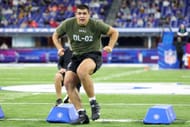
Riser: Bryan Bresee, Clemson
Considering he’s been seemingly falling in the predraft process without any further information – other than people connected to NFL front offices saying he’s not as highly touted as some may think – I’m happy to show Clemson’s Bryan Bresee some love after a very challenging year off, and to some degree, on the field as well.
Bresee weighed in just two pounds shy of the 300-mark, yet he still ran a 4.86 in the 40, which was fourth among the IDL group. And he was between 7 and 17 pounds heavier than all of those three guys ahead of him. Plus, his 1.71 10-yard split was tied for second. Other than that, he only did the vertical jump and bench press, where he was to eight in both.
But it was his on-field workout that really impressed me. He looked very light on his feet, with no wasted movement going through the bag drills, turning a tight corner as he synced his hands and hips together. His hands were quick and forceful.
Plus, towards the end, when asked to string together multiple moves in a D-line gauntlet, he stayed tight to the bags, even on a compact spin move, which isn’t necessarily a portion that favors bigger guys, where somebody like Bresee, at 6-foot-5½, had to reduce his frame.
I’d be remiss not to bring up Pittsburgh’s Calijah Kancey basically showing the exact same athletic profile as another former Panther and three-time Defensive Player of the Year Aaron Donald (outside of arm length), with a 4.67 in the 40 and a 1.64 split, but he didn’t do anything else.
And a 4.85 with a 1.72 split is a great time for West Virginia’s Dante Stills at 286 pounds. After murdering people at the East-West Shrine Bowl, he continued to look explosive in his movement and in the way he plants off his foot to change direction and navigate through the bags without losing his balance at any point. And his ability to dip that shoulder and effortlessly execute the figure-eight on the “run the hoop” drill was also very impressive for his height.
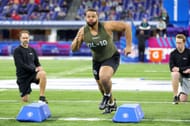
Faller: P.J. Mustipher, Penn State
Former Nittany Lion P.J. Mustipher had the worst 40 time of any defensive player at a 5.41, despite three of the four guys directly in front of him having about 15 pounds on his 320. And the 1.88 10-yard split might have been even worse, as it was tied for the slowest mark with Baylor’s fridge-like Siaki Ika.
Mustipher was tied for third-worst vertical jump, and he had the shortest broad jump, hitting just 8 feet. And I don’t even know who advised him to do the agility drills, since he was dead last in both as well, going over the eight- and five-second marks respectively for the three-cone and short-shuttle drills.
Along with that, Mustipher was high in his movement on the field during the wave drill and others. He looked rather sloppy in his transitions, sort of pausing at times almost as if he didn’t want to slip later on. For a guy who I think was a pretty integral piece to a great Penn State defense the last few years but had very little production – not reaching more than 1 sack in any of his 4 seasons as a starter – this really isn’t good.
Texas’ Keondre Coburn looked like a big body who you can put in the middle of your defense for a couple of downs maybe, but there’s nothing athletically that excites at all. He showed tightness in his ankles and didn’t lift his feet off the ground or plant off them very well. He is what he is – a space eater.
Edge defenders
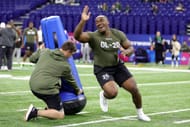
Riser: Adetomiwa Adebawore, Northwestern
Let’s get to the main event now. And there’ll be guys higher up in terms of people throwing out combine risers or whatever, but nobody throughout last week impressed me more than Northwestern’s Adetomiwa Adebawore.
Let me just approach it this way: Last year, people went nuts when Travon Walker killed the combine, and the hype got so much that he ended up going first overall to the Jacksonville Jaguars. Ade ran a 4.49 in the 40, with a 1.61 split, a 37.5-inch vert and a 10-5 broad jump. Those results are all better than Walker's, despite weighing 10 pounds more (!) at 282. He didn’t do the agility drills, but he did put up 27 reps on the bench press with basically 34-inch arms.
The guy was zooming through the bags on the ground and seemed to have no issues changing directions, which was better than just on par with the pure edge rushers, who weigh 30-40 pounds less. That ability to snap his hips as he’s making those 90-degree turns and swiping by the bags, and how glued he was to the dummies on the DL gauntlet, to not get off track at all, was great to see as well.
Even doing off-ball linebacker drills, he looked better than guys who won’t play with their hand in the dirt more often than not. It was just a ridiculous showcase, and after already impressing at the Senior Bowl, I think he has a legit chance of sneaking into the back end of round one.
Iowa’s Lukas Van Ness certainly deserves to be mentioned here – 4.58 in the 40 at 272 pounds, way too smooth than he should be for his size, and there’s some real snap in his hands. He was also behind only Eastern Michigan’s Jose Ramirez among edge defenders in the three-cone (7.02) and short-shuttle (4.32), to showcase his lateral agility, considering he was very much a pure power player at Iowa.
Both Georgia outside linebackers Nolan Smith and Robert Beal were obviously very impressive as well, with Smith’s 4.39 being one of the fastest times ever seen from an edge guy.
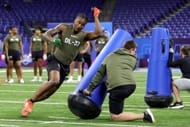
Faller: Isaiah Land, Florida A&M
As I mentioned at the top here, I labeled these players based on what they played in college and how they are typically listed on different boards, which has Florida A&M’s Isaiah Land making an appearance for this edge group.
For how much lighter he was than pretty much everybody else listed at defensive end at 236 pounds, I needed him to run a great time. However, he was only about average with a 4.62, and so was his 1.65 10-yard split. I thought there wasn’t much pop in his hands and he got too wide when he should’ve tightly navigated around the bags.
The NFL probably looks at Land as an off-ball linebacker mostly anyway, but even then, the athleticism isn’t anything beyond the standard; it's not enough to make him super appealing. And he was probably even helped a little bit by working out with guys who typically have their hand in the dirt and weren’t quite as clean doing the bag drills, as if he was labeled with the true LBs – which we saw for a bunch of legit edge guys, such as Alabama’s Will Anderson.
The only positive about Land’s performance was the 10-6 broad jump. I guess some of the buzz about him coming out of the Senior Bowl will now vanish mostly.
And, my god, the stock for Army’s Andre Carter just continues to drop. With some of the strength questions I had already – only 11 reps on the bench press? And a 9-1 broad jump? Both were dead last for the group. Plus, not even cracking 34-inch arms at 6-6½ when his calling card was length? That’s just rough.
Linebackers
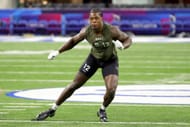
Riser: Shaka Heyward, Duke
I could, of course, go with one of the two freak athletes here. Auburn’s Owen Pappoe or Clemson’s Trenton Simpson ran a 4.39 and 4.43 respectively in the 40, along with surprisingly two of the four best marks on the bench press. But we knew coming into the week that they’d be freakishly fast at least. So, based on my expectations, I was more impressed with Duke’s Shaka Heyward.
For a pretty good inside thumper inside, Heyward's 4.53 40 while being right around an NFL-average size of 235 pounds was a great time for him. When you combine that with measuring in at 6-3 with 34-inch arms, you see the tools to be a matchup asset in coverage.
I was already pretty impressed with him at East-West Shrine practices. And he looked very smooth in the coverage drills, redirecting with the shuffle, staying low in his pedal and quickly sticking his foot in the ground to drive forward when taking directions on the wave drill. His hips looked loose, and he snatched the ball away from his body on multiple occasions when asked to open and pivot.
For a guy who was labeled as a below-average athlete who may have problems changing directions due to his longer legs, I think he had a very positive showing in an LB class without much clarity.
Tennessee's Jeremy Banks and Washington State's Daiyan Henley also ran well and made up good ground in the on-field drills, while still cleanly getting out of their transitions.
Henley, in particular, was so tight in his change-of-direction, not taking any unnecessary steps or having any delay on those. And Banks will be one of my biggest draft crushes, just continuing to tick boxes, after I thought he had a tremendous Shrine Bowl week himself.
Iowa's Jack Campbell is a guy with some of the cleanest tape you’ll find in terms of processing the game from the second level and letting his eyes take him to the ball. Even though his 4.65 in the 40 isn’t great, to easily have the best agility drills of the group at 6-5, 250 pounds – so, real old-school linebacker size – is outstanding for him.

Faller: Jalen Graham, Purdue
There was far less of an obvious choice. I wouldn’t say there were many LBs who really stood out in a positive sense, but at least there we didn’t have anybody running in the 4.7s or have any other really bad measurements. Since I do have to talk about somebody here, I went with Purdue’s Jalen Graham.
First of all, he ran the third-slowest 40 time among linebackers at 4.64 despite coming in at only 220 pounds. That’s a bit of a red flag already – and his 10-yard split of 1.68 is six-hundredths of a second worse than anybody else from that group. Then, he also had the weakest jumps at 30.5-inches in the vert and just a 9-4 broad.
Moreover, he just seemed to be straining when changing directions during the on-field stuff and looked really sloppy going through the bag drills, when you’d like to see him properly step around or over them and not lose time when touching down on the bags. He also body-caught the ball and stumbled while trying to work around the bags off the hand-swipe moves.
So, at that weight, there’s no way you can think about making him a safety, which is what he was recruited as. What is the positive of using him as a dime backer when he doesn’t look good in those areas you’d sub him on for in place of heavier bodies?
Cornerbacks
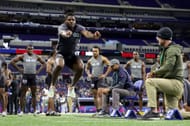
Riser: Deonte Banks, Maryland
My god, this class was outstanding – which I called for the day of them getting onto the field – and I had a tough time even picking one here. The name I ultimately settled on is Deonte Banks from Maryland.
At 6-0 and 197 pounds, Banks ran a 4.35 in the 40 and was No. 1 among all corners with a 42-inch vertical and second in the broad jump at 11-4.
He didn’t do the agility drills or bench, but he had an excellent on-field workout – where he stayed low in his pedal, was able to drive out of it with explosion and flip his hips without issues despite that longer build, and he didn’t have any drops. Banks did T-step a little bit in the W-drill, which I personally don’t like to see, but that is more so about what guys are getting coached to do in college.
Meanwhile, he caught the ball with confidence and I also only counted one drop during the gauntlet drill. This is one of the deepest corner classes I've ever evaluated, but some guys have to go early, and when I combine this performance with his tape, Banks certainly feels like a first-rounder. So, lock him into your mock drafts.
And, of course, we have to bring up Banks’ former running mate at corner in Jakorian Bennett, who actually bested his guy with a 4.3 flat in the 40, top-four marks in both the jumps and a good on-field workout.
At the same time, Oregon’s Christian Gonzalez may have separated himself from that trio of corners at the top, based on consensus rankings, in the eyes of some teams with tremendous all-around performances in testing and on-field drills.
Julius Brents from Kansas State, meanwhile, absolutely jumped out of the gym with a 41.5-inch vert and an 11-6 broad jump. And while not all corners participated, his agility numbers were also both significantly better than the next-closest name. For a legit 6-3 with 34-inch arms, that’ll be very intriguing for NFL teams.
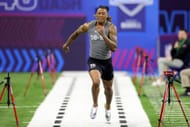
Faller: Jaylon Jones, Texas A&M
Jaylon Jones had the second-worst 40 among CBs at 4.57 despite his 10-yard split at 1.48 being tied for second-best among the group. So, that confirms what I think about him: being able to drive on stuff in front of him and be a physical C2 corner, but his deep speed is a real issue and limits what he can be at the next level.
The jumps were OK, but I didn’t like what I saw on the field, either. He tried to T-step early on in the W-drill, but slipped twice on the first break and was a bit timid when he finally made it through the drill. Plus, he slipped a bit again when simulating a curl-to-pivot route, where they had to open one way and then make that full 180-degree turn.
I will give him credit for the way he caught the ball, and maybe there simply was some bad choice with the footwear, but there's too many really good corners in this group to have a performance like that. He’s going to be a scheme-specific player, and a team that buys into his special teams value will bring in some time on Day Three.
Also, Virginia’s Anthony Johnson was rough in his testing – he was dead last with a 4.63 in the 40, the vert at 30.5 inches and just an inch away from the very bottom of the list with his 9-7 broad jump.
Safeties
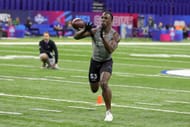
Riser: Jartavius Martin, Illinois
As far as safety goes, there are a couple of names that looked pretty good, but none made noise like Illinois’ Jartavius Martin.
He absolutely jumped out of the gym as well. His 44-inch vertical jump tied him for fourth-best all-time for any position, and he also led the safety group with an 11-1 broad jump, along with being just three-hundredths off the top mark in the 40 at 4.46.
During on-field drills, I thought he covered good ground and had a couple of nice high-point grabs. Watching him go through the W and one of the other transition drills, I thought the foot-fire to change directions was very impressive, too. He also got out of the gauntlet clean, without any drops, at the end of the session.
I liked Martin from the limited tape I watched on him, but I was more so tracking him while studying his teammates, Sydney Brown and Devon Witherspoon, whom I both absolutely adore. I’ll have to go back to the tape for him specifically and see if I may like his skill set to play more in the post with those kind of explosive numbers, along with being an effective slot already for the Illini.
Martin’s former teammate, Sydney Brown, of course, had an excellent performance, with top-level testing numbers and a smooth workout. And Cal’s Daniel Scott had a really nice performance as well, in terms of the testing and how loose his hips looked.
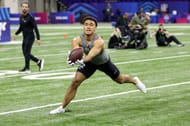
Faller: Brandon Joseph, Notre Dame
With his 4.62 in the 40, Joseph was tied for the fourth-slowest time among safeties. And two of the three guys he finished ahead of are players I would certainly define as box safeties or big nickels. He's not somebody who people looked at as a potential first-rounder as a true center-fielding free safety a couple of years ago.
I didn’t think Joseph was making up a whole lot of ground when having his hips flipped and trying to gain depth, and for somebody whose calling cards are his range and ball-skills, having four passes (!) come off his hands during the drills was unacceptable.
That’s not including the gauntlet, where he caught every ball. But the pure speed, ability to make up ground when his body isn’t fully committed and lack of security hauling in passes will definitely cost him. I feel it’s been a constant fall for him across a year-and-a-half. He may ultimately not hear his name called until Day Three.
Florida’s Trey Dean running a 4.75 limits what teams project him as at the next level, of course, but I think he was looked at as a tight end matchup player or down-safety anyway. For his size, he was able to flip and run really well, along with making some tremendous grabs. Plus, he repped off a DB-best 25 on the bench press.
Quarterbacks
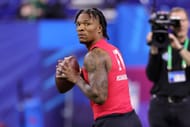
Riser: Anthony Richardson, Florida
Really, all three of the top four quarterbacks who decided to throw – not including Alabama’s Bryce Young, who won just by showing up with basically the same measurements as former No. 1 pick Kyler Murray – looked good out there.
Ohio State’s C.J. Stroud, in particular, just made everything look so effortless, with a solid base, smooth release and great ball-placement. Kentucky’s Will Levis had great zip on the ball and was calm in his footwork, because he was comfortable hanging at the top of his drop and showing off his self-proclaimed “cannon” – although I would've liked to see him let it rip even more.
But how can I not talk about Florida’s Anthony Richardson here? The athletic testing is just stupid. A 4.43 in the 40? A 40.5-inch vert and a 10-9 broad jump, at 244 pounds? Are you kidding me? Those marks are significantly better than Cam Newton, who body-type wise seems like a close comp.
Along with that, just the power behind his release, the flick of the wrist being so easy to him, driving the ball on shake routes and speed outs towards the sideline. And then the showcase throws on the go-balls, where he let it fly 65 yards – with pace – it was really fun to watch.
While there are obvious questions on tape, I think many people undersold what he already showed with just over one season of starting experience, and there have to be several teams very intrigued with the idea of a freak like AR-15. I wouldn't be shocked if he ends up going as high as second overall. There's no chance he'll make it out of the top nine.
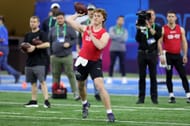
Faller: Max Duggan, TCU
There’s really only so much you can do to hurt your stock as a quarterback, jumping and running around in underpants, before throwing routes versus air to receivers you’ve never linked up with, but if there was one guy who definitely didn’t help himself, it would be TCU’s Max Duggan.
He ran a 4.52 in the 40, which was second-best to only Anthony Richardson, but other than that he had the worst or second-worst mark in all the other testing marks, and I have to question why he even participated in all of them.
I thought he was also safe with his throws, forcing receivers to turn for the ball at the sideline or slowing down on deep balls in order to get the completions, but that’s not really what the coaches, GMs and scouts want to see in Indy. It’s about the ability to put the ball to a spot, where defenders won’t be able to make a play.
Just watching the first three slants he threw, they all came out different – one low, then high and finally slightly behind the target. He’s not the most consistent guy in terms of his mechanics, and he already missed a chance to stand out during Senior Bowl week.
I’m not going to act like Richardson was perfect and what we saw with him and Duggan in terms of their legs going a little bit maybe later on, because they were doing all the testing stuff. Yet, at least you saw how easily the Florida QB was able to flick it in contrast to Duggan.
Wide receivers
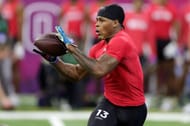
Riser: DeMario Douglas, Liberty
This is a guy I’ve shouted out on multiple occasions this offseason already. We already knew he was small, and at 5-8, 179, we needed to see him stand out to some degree athletically – which he did. That 4.44 in the 40 matches his game speed. Douglas was also tied for fifth among WRs with a 39.5-inch vert and was just one inch behind the top mark in the broad jump at 10-8.
He showcased a nice burst out of his breaks, confidently caught the ball during the gauntlet and had a great diving grab on a deep in-cut once. You saw him turning upfield smoothly and rapidly after securing the catch consistently, and he looked like a guy who all of that comes to pretty naturally.
You take that along with how he was cooking DBs throughout East-West Shrine week – which I already outlined him for in my article on the biggest standouts from the college all-star events. And he has probably moved up significantly on a lot of boards around the league during this process, as somebody who because of physical measurements will be available on Day Three, but he may go a lot earlier than expected once the 2022 season ended.
Ohio State’s Jaxon Smith-Njigba didn’t run the 40, but he put up elite agility numbers, which were tops at the entire event, as well as two and three tenths of a second better than anybody else for the WR group respectively. And he just looked so smooth during the on-field portion, with fluid route-running, adjusting to the ball and getting upfield effortlessly.
Two of the bigger receivers in Princeton’s Andre Ioshivas and West Virginia’s Bryce Ford-Wheaton ran better than expected, along with the former finishing behind only JSN in both agility drills, while the latter was tied for the group’s top mark with a 41-inch vert.
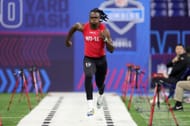
Faller: Dontay Demus, Maryland
Meanwhile, Maryland’s Dontay Demus was pretty far down the list with a 4.57 in the 40, but I just didn’t like the way he moved on the field, to be honest. He lacked juice in his routes and wasn’t crisp at all in his breaks. He struggled to catch the ball cleanly a couple of times early on, even though he was able to get that done as the workout continued. But his play speed is questionable going up against NFL DBs – and that’s what I wasn’t sure about watching his tape as well.
It’s obviously not his role, as he was a pure outside receiver at Maryland, but watching him run the pivot route, it was more so a shuffle into the cut rather than exploding off the inside foot – you’ll see some tight-ends be cleaner in those transitions.
To me, with the athletic profile confirming mostly what I saw on tape, I just look at him as a limited player, who may have his role as a red-zone specialist, where his ability to catch the ball through contact and position his body accordingly is very good. But other than that, he’s a pure outside receiver with a small route tree to work off, and not that much else to offer.
South Carolina’s Jalen Brooks also had some pretty bad testing, including the worst 40-time for the position at 4.69 and the slowest three-cone drill, coming off with just one season of fairly good production. He did at least hit the 6-foot and 200-pound mark in a very small WR class, but a lack of athletic tools will only be more highlighted by who’s up before and after him.
Tight ends
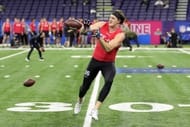
Riser: Zack Kuntz, Old Dominion
This is one of the easier choices on this entire list. How could it not be Old Dominion’s Zack Kuntz? He was just one-hundredth of a second in the 40 and four-hundredths in the short shuttle away from sweeping the board for tight ends. So, to quickly bring up the numbers for this guy at 6-7, 255 – 4.55 in the 40, a 40-inch vert, a 10-8, broad jump, a 6.87 three-cone, a 4.12 short shuttle and 23 reps on the bench press.
In terms of the on-field drills, I thought he could have gotten out of his breaks a little bit quicker maybe. But he is coming off an undisclosed injury, where watching it again, he got his leg twisted underneath a tackler – so either an MCL sprain or an ankle probably – maybe still getting back to 100% confidence, being able to plant off that foot.
Other than that, he consistently extended away from his frame and showed soft hands, along with instantly tucking it away, which was apparent with how easily he made it through the gauntlet. To be such an athletic outlier with high-level production when given a chance to contribute after transferring from Penn State – albeit against slightly lesser competition – even in a very strong TE class to be fair, this kid may have thrown his name in the ring as a surprise pick late on Day Two.
For as crafty as he is already and how well he catches the ball, Iowa’s Sam LaPorta running a 4.59 at 245 pounds, having top three numbers in both the agility drills and how fluid he looked on the field, not even breaking a sweat it felt like, that definitely helped him.
And, of course, just seeing the monstrous measurements of Georgia’s Darnell Washington running a 4.64 at 264 pounds, with the largest wingspan for TEs at the combine (83 3/8 inches) and that sick one-handed grab on a goal-line fade, it puts you in awe. But maybe most impressive: his 4.08 in the short shuttle was third-best at the combine, regardless of position, and the two guys ahead of him were both less than 200 pounds.
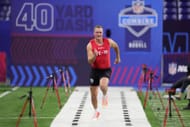
Fallers: Josh Whyle and Leonard Taylor, Cincinnati
There’s not really one guy I feel worthy of being outlined here in a negative way, but since I did want to mention somebody at each position, I will go with a combination of the two Cincinnati TEs.
Josh Whyle’s 4.69 in the 40 was below average for the group, along with having the fourth-worst vertical jump at 33.5 inches, and he was tied for the worst broad at 9-7. Also, having only 31½ -inch arms at 6-6½ isn’t great, either. Running routes and catching the ball, he was thankfully able to make up for some of that.
Meanwhile, Leonard Taylor didn’t take part in any of the testing, but his on-field workout simply wasn’t very good. He wasn’t crisp on a couple of breaks, and just the way he addressed the football down the field was poor. The first pass on a slot fade route slipped right through his hands, because he didn’t keep his pinkies together, and the same thing happened on the other side of the field on more of a wheel route later.
To end the day, he made a nice-looking pirouette catch on a goal-line fade, but unfortunately didn’t survive the ground, because he didn’t pull the ball into his body in time. During the gauntlet was actually where he looked best in that regard.
Also, while trying to secure the title as TE1, especially with Utah's Dalton Kincaid not partaking, Notre Dame’s Michael Mayer couldn’t really put up any of the athletic marks you’d like to see. A 4.7 flat in the 40 and just a 32.5-inch vert aren’t great endorsements.
Offensive tackles
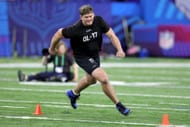
Riser: Blake Freeland, BYU
This is a position where I considered a couple of names, but I ultimately went with BYU’s Blake Freeland. Whenever you break a record for your position, I believe you deserve to be mentioned on a list like this, and Freeland’s 37-inch vertical jump is pretty insane for a guy just above the 300-pound treshold.
He also hit the 10-foot mark for the broad jump, which was five inches better than the next-closest O-lineman and was just one-hundredth of a second off the top mark in the 40 for the position – with a 4.98 to his name – while the more important 10-yard split at 1.68 led the group.
Freeland’s height led to him still being a little tall during the change-of-direction stuff in the actual on-field portion, but he covered good ground with those long strides on pulls. There wasn’t really any wasted movement, and you saw that explosiveness out of his stance a couple of times when getting out on pulls.
I think, at 6-8, my questions about pad-level and ability to anchor in pass-protection are still there, but in terms of athletic profile, the ceiling for him is sky-high, and there’s plenty of room upwards to counter-balance some of the problems that height may present. I promise you, that’s what every O-line coach in the NFL is saying right now.
A couple of other names to mention here.
Broderick Jones of Georgia put up the best time among all offensive linemen at 4.97. He also looked well-coordinated in his movement during the on-field drills and showed that burst on longer pulls. Plus, he had a really fun finish to the workout when he basically tossed one of the coaches aside as he released on the screen drill.
And, although they didn’t run, but Syracuse’s Matthew Bergeron and Tennessee’s Darnell Wright both had tremendous field workouts. They looked so light-footed, changing directions, reacting to the coaches’ indications and the speed when they were allowed to get on the move. All super impressive.
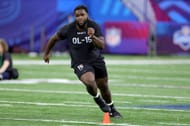
Faller: Mark Evans II, Arkansas Pinebluff
Before he even got to any of the athletic testing, Evans’s 32 3/8-inch arms will probably make him a guard only on most teams’ boards. However, he was listed at OT, and for that label, his 5.44 in the 40 was the second-worst among the group and the 1.9 10-yard split was actually ahead of only Ohio State’s Dawand Jones among all linemen – who weighs 71 pounds more (!) than Evans at just above 300.
I thought Evans actually looked solid during the on-field workout, other than when he had to kind of bend his path on the fly. And I won’t bang him too much for that performance, but especially for small-school names like this, having some of the worst testing numbers, there’s less motivation for higher-ranked guys in NFL organizations other than area scouts to get to – and fall in love with – his tape.
Going back to the East-West Shrine practices, I noted that he had some impressive reps of mirroring interior rushers laterally – which we also saw during the mirror drill in Indy. I hope I can personally get to his tape by the time I put out my IOL rankings, but even for me, that’ll probably push him behind a couple of other names on my personal watch list.
Baylor’s Connor Galvin was another guy who disappointed. First, at just 293 pounds, he was tied for the second-worst 40 time among all players, and he also looked very skinny. I thought on tape he had some issues staying low and absorbing power, which continue to be question marks for me, because he wasn’t moving around with sufficient sink in his hips to make up for the lack of bulk.
Something that has to be mentioned here is Northwestern standout Peter Skoronski measuring in with only 32¼-inch arms. That may make him a guard only for some teams who have hard benchmarks – and the general one is 33 inches. Nothing Skoronski did actually hurt his stock otherwise. He performed well. It’s just that one question we all had now being answered.
Interior O-line
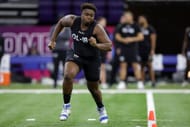
Riser: Jon Gaines II, UCLA
There wasn’t really as obvious a choice on interior. I thought LSU’s Anthony Bradford moved around really well during the on-field workout and was tied for the second-best 10-yard split among the interior O-line. Alabama’s Emil Ekiyor continues to have a strong predraft process after showing the flexibility to play C at the Senior Bowl. Just with the burst out of his stance and how well-coordinated he looked in drills, even though he didn’t test at all.
Yet, I would be remiss not to talk about a guy who I haven’t studied yet, but definitely will now, and that’s UCLA G Jon Gaines II.
I’m very familiar with the play of the other Bruin guard Atonio Mafi – who I highlighted after an awesome Shrine Bowl week and I thought was a massive combine snub. But I didn’t actively watch Gaines even, because based on consensus rankings, he’s currently projected to go undrafted. That probably changes after the way he dominated the testing in Indy.
Clemson’s Jordan McFadden is labeled as a guard on NFL.com, but considering he always played tackle in college, I will just count him as such, which would give Gaines the best time in the 40-yard dash among the IOL, just one-hundredth of a second over the 5-second mark.
His 1.73 10-yard split was tops for the group. So were the 32.5-inch vert and 9-6 broad jump, and he also had the best times of all offensive linemen in both the agility drills, with the 4.45 in the 20-yard shuttle in particular being the best mark for any interior guy since James Daniels in 2018.
That explosiveness and ability to change directions also showed up on the field, with an elite mirror drill, and his footwork just looked so well-coordinated. So, I don’t mind at all going back to the UCLA O-line at all, and I’ll have my eyes locked on Gaines this time around before I give out any projections.
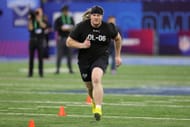
Faller: Oregon’s T.J. Bass
This one was kind of rough to watch. Bass' 5.48 in the 40 was tied for second-worst in Indy, while the 1.86 10-yard split was just one-hundredth of a second better than the worst mark among the interior O-line. And his 28.5-inch vert wasn’t great either.
I thought on the field in what they refer to as the wave drill – where a coach gives him directions – Bass looked clunky in his transitions. You saw his heels click, and he just wasn’t able to move very well with sink in his hips. Turning the corner on pulls, there were some unnecessary steps and a lack of short-area burst that you’d like to see.
He also didn’t look really comfortable stopping his feet to take the direction off a coach, after coming around on lead- and skip-pulls. At least the mirror drill looked pretty balanced, but I’m not sure that if that was a twitchy interior rusher instead of a coach across from him, he would’ve been able to stay square to them with the ground he covers laterally.
He’s just a heavy-footed guy and I haven’t studied individual Oregon O-linemen, but there’s a lot of Day Three interior guys I like quite a bit. So, I have a tough time seeing him be a name that I’ll have high on my final rankings.
Washington’s Henry Bainivalu had the worst mark in the 40 and both the agility drills among players in Indy, but I thought he looked good in the on-field stuff. So, I won’t drag him too much for it.
Running backs
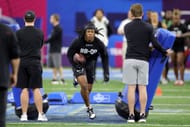
Riser: Jahmyr Gibbs, Alabama
First and foremost, we knew Texas A&M’s Devon Achane could fly, and the 4.32 he ran is great – but that was pretty much my expectation (as crazy as that sounds). Texas’ Bijan Robinson had a great all-around workout, particularly with how naturally he caught the ball and how he never seemed to be straining.
However, my guy here is Alabama’s Jahmyr Gibbs. When you look at different draft evaluations, the comp you see over and over again is the Saints’ Alvin Kamara, and I see a lot of that from Gibbs. But Kamara ran a 4.56 at his combine – Gibbs was two-tenths of a second faster than that, which put him behind only Achane among running backs.
Along with that, he just made the entire workout look almost effortless. So easy stepping over and navigating around the bags, not stuttering his feet or slowing himself down at all. Several RBs seemed to have issues with the Deuce Staley drill, but Gibbs just went through it as if he didn’t even have to think about it. On top of that, the reactionary suddenness to immediately cut as he got directions from the coaches was different than most of the group.
Perhaps most telling about him as a player though is what he did as a receiver. There was no wasted movement as he ran routes. He cleanly got out of his breaks, never even had a bobble with the ball and the only one he didn’t catch was thrown by a scout once they sent the throwing QBs off, where the ball was just a tad off. And, of course, Gibbs hauled in that final wheel route on the re-do.
Bijan has been RB1 was all along, but this guy is firmly entrenched as the next guy I believe, and he still has a good chance of going late in the first if a contending team feels like they can maximize his skill set.
UCLA’s Zach Charbonnet is the third name in this discussion, and he checked another box. His 4.53 in the 40 at 214 pounds is really good, and the 1.54 10-yard split is especially what you want to see. He was also fifth in the vert and seventh in the broad jump. On the field, he was effective with his cuts and caught the ball naturally.
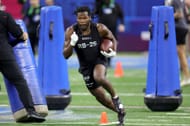
Faller: SaRodorick Thompson
Now, let's get to the final name I have to bring up in a negative sense. Thompson came in a bit lighter than I expected at 207 pounds after the Red Raiders had him listed at 220, and he measured a half-inch short of 6 feet, with some of the smaller hands, right at 9 inches. The testing across the board was subpar. His 4.67 in the 40 was ahead of only Utah’s Tavion Thomas, who outweighs him by a full 30 pounds.
Thompson was also bottom five in both the jumps and surprisingly took part in both the agility drills, where the only other RB to even follow suit was Northwestern’s Evan Hull, who easily bested Thompson by more than three-tenths of a second in both. In fact, his 4.7 flat in the short shuttle was the worst mark of any non-offensive or defensive lineman at the entire event – with multiple of those guys in front of him, too.
He caught all the balls thrown his way and didn’t stumble over his own feet or anything like that, but it does take a beat for him to turn upfield after catching the ball, and he didn’t make any explosive cuts that would make you feel better.
Thompson had a solid Senior Bowl week after filling in for Texas' Roschon Johnson, who got hurt on Day One, and you have to admire the willingness to compete in all areas. But in an extremely deep RB class, a performance like this may lead to you not getting drafted.
Camrun Peoples from Appalachian State also stepped on the bags and tripped over them. He looked overwhelmed on the Deuce Staley drill, where he didn’t pick the right hole when the trainers indicated where he should go with the upright bags.
He didn’t drop any passes, but he clapped at the ball on a few of them and didn’t have his hands aligned properly. In Mobile, Alabama, I thought he caught the ball pretty well until a couple of blatant drops in the Senior Bowl. So, with extremely limited receiving production in college, that’s an area he’ll need to prove himself to NFL teams.
If you enjoyed this analysis, please consider checking out the original video, and feel free to check out my page halilsrealfootballtalk.com for more detailed content like this.
"Caught more bags than touchdowns": NFL fans react to Garrett Wilson's blockbuster $130,000,000 contract extension
